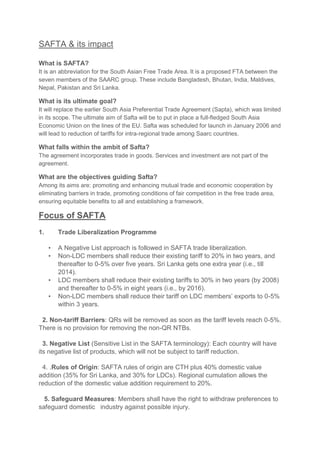Safta
- 1. SAFTA & its impact What is SAFTA? It is an abbreviation for the South Asian Free Trade Area. It is a proposed FTA between the seven members of the SAARC group. These include Bangladesh, Bhutan, India, Maldives, Nepal, Pakistan and Sri Lanka. What is its ultimate goal? It will replace the earlier South Asia Preferential Trade Agreement (Sapta), which was limited in its scope. The ultimate aim of Safta will be to put in place a full-fledged South Asia Economic Union on the lines of the EU. Safta was scheduled for launch in January 2006 and will lead to reduction of tariffs for intra-regional trade among Saarc countries. What falls within the ambit of Safta? The agreement incorporates trade in goods. Services and investment are not part of the agreement. What are the objectives guiding Safta? Among its aims are: promoting and enhancing mutual trade and economic cooperation by eliminating barriers in trade, promoting conditions of fair competition in the free trade area, ensuring equitable benefits to all and establishing a framework. Focus of SAFTA 1. Trade Liberalization Programme âĒ A Negative List approach is followed in SAFTA trade liberalization. âĒ Non-LDC members shall reduce their existing tariff to 20% in two years, and thereafter to 0-5% over five years. Sri Lanka gets one extra year (i.e., till 2014). âĒ LDC members shall reduce their existing tariffs to 30% in two years (by 2008) and thereafter to 0-5% in eight years (i.e., by 2016). âĒ Non-LDC members shall reduce their tariff on LDC membersâ exports to 0-5% within 3 years. 2. Non-tariff Barriers: QRs will be removed as soon as the tariff levels reach 0-5%. There is no provision for removing the non-QR NTBs. 3. Negative List (Sensitive List in the SAFTA terminology): Each country will have its negative list of products, which will not be subject to tariff reduction. 4. .Rules of Origin: SAFTA rules of origin are CTH plus 40% domestic value addition (35% for Sri Lanka, and 30% for LDCs). Regional cumulation allows the reduction of the domestic value addition requirement to 20%. 5. Safeguard Measures: Members shall have the right to withdraw preferences to safeguard domestic industry against possible injury.
- 2. Safeguards will not apply to an LDC product if the share of import from LDCs is less than 5% of the total import of the importing country in that product. Benefits of SAFTA âĒ SAFTA will bring significant gains for the small economies of the region. âĒ It will attract foreign capital. âĒ It will be a step toward better political relations and peace. âĒ Part of the informal trade will be diverted to official channels and bring revenue and other benefits. âĒ Elimination of tariffs will increase intra-regional trade by 1.6 times the existing trade. âĒ Dynamic gains will be more significant than static gains. Drawback of SAFTA âĒ SAFTA does not meet the standard economic criteria for successful integration (other than high pre-FTA tariff and geographical contiguity). âĒ Other requisite criteria are high levels of international trade before the formation of the FTA, high degree of trade complementarily, secure market access (no tariff, no NTBs). âĒ Long sensitive lists of members will lower the benefits of trade. âĒ SAFTA will benefit India the most. Some member countries may even lose âĒ Because of similar production structures in member countries, the expansion of intra-regional trade will be limited. âĒ SAFTA will lead to trade diversion. âĒ SAFTA will contribute to the âSpaghetti bowlâ phenomenon, where many applicable tariff rates and multiple sources of origin will create confusion and difficulty among customs officials and producers. Relation with FDI âĒ SAFTA, by lowering intra-regional tariffs, enhances the possibility of increased FDI from outside the region. âĒ Opportunities for intra-regional investment increase, too, including joint ventures. Lower tariffs among members make FDI attractive. âĒ SAFTA may act as a spur to Indian investment in SAARC countries as the experience of Sri Lanka and Nepal indicates.



